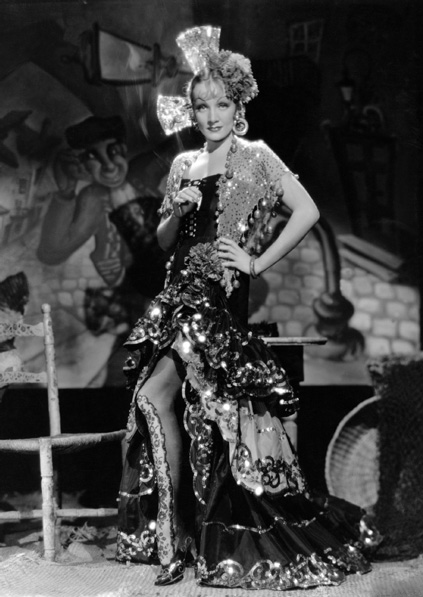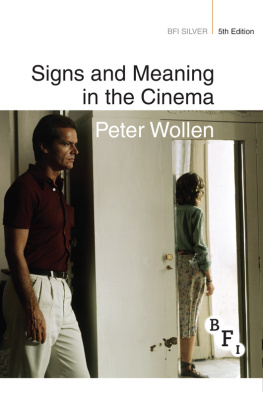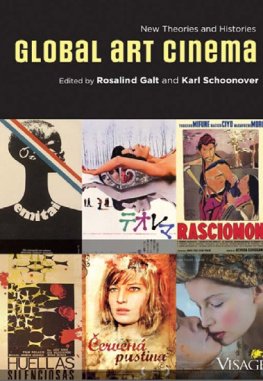BFI SILVER
Representing the very best in critical writing on films and film-makers, these beautifully presented new editions and reissues of classic titles from BFI Publishing feature new introductions by leading film critics or scholars. They assess the unique contribution of the work in question and its author to the field of film studies and to the wider public understanding of moving image culture.
ALSO AVAILABLE:
Fetishism and Curiosity: Cinema and the Minds Eye
Godard
A Lang Hard Look at Psycho
Mamaulian
A Mirror far England: British Movies from Austerity to Affluence

Marlene Dietrich in The Devil is a Woman
Signs and Meaning in the Cinema
5th Edition
Peter Wollen
with a foreword by D. N. Rodowick

This publication British Film Institute 2013
First published by Secker & Warburg in association with the British Film Institute 1969
Second edition published by Thames and Hudson 1970
Third edition published by Secker & Warburg, revised and enlarged 1972
Fourth edition published by the British Film Institute, revised and enlarged 1998
Copyright Peter Wollen 1969, 1970, 1972, 1998, 2013
Foreword David Rodowick 2013
All rights reserved. No reproduction, copy or transmission of this publication may be made without written permission. No portion of this publication may be reproduced, copied or transmitted save with written permission or in accordance with the provisions of the Copyright, Designs and Patents Act 1988, or under the terms of any licence permitting limited copying issued by the Copyright Licensing Agency, Saffron House, 610 Kirby Street, London EC1N 8TS. Any person who does any unauthorized act in relation to this publication may be liable to criminal prosecution and civil claims for damages. The author(s) has/have asserted his/her/their right(s) to be identified as the author(s) of this work in accordance with the Copyright, Designs and Patents Act 1988.
This edition published in 2013 by
PALGRAVE MACMILLAN
on behalf of the
BRITISH FILM INSTITUTE
21 Stephen Street, London W1T 1LN
www.bfi.org.uk
Theres more to discover about film and television through the BFI. Our world-renowned archive, cinemas, festivals, films, publications and learning resources are here to inspire you.
Palgrave Macmillan in the UK is an imprint of Macmillan Publishers Limited, registered in England, company number 785998, of Houndmills, Basingstoke, Hampshire RG21 6XS. Palgrave Macmillan in the US is a division of St Martins Press LLC, 175 Fifth Avenue, New York, NY 10010. Palgrave Macmillan is the global academic imprint of the above companies and has companies and representatives throughout the world. Palgrave and Macmillan are registered trademarks in the United States, the United Kingdom, Europe and other countries.
Series cover design: keenan
Cover image: The Passenger (Professione: reporter) (Michelangelo Antonioni, 1974), Compagnia
Cinematografica Champion
Designed and set by couch
Printed in China
This book is printed on paper suitable for recycling and made from fully managed and sustained forest sources. Logging, pulping and manufacturing processes are expected to conform to the environmental regulations of the country of origin.
British Library Cataloguing-in-Publication Data
A catalogue record for this book is available from the British Library
A catalog record for this book is available from the Library of Congress
ISBN 9781844573608 (pb)
ISBN 9781844573615 (hb)
Foreword
D. N. RODOWICK
Dear Peter,
Signs and Meaning in the Cinema is now more than forty years old. Can you imagine? I was so deeply touched when Laura and Leslie asked me to write a Foreword for the new edition. Foreword is an interesting word, dont you think? It should be the word that comes before the book. Yet every word I could possibly imagine would have to follow upon and to take account of its enormous debt to what you have already thought and written. Foreword is also close to forward, which might mean that Signs and Meaning remains a very young book, still turned towards the future. In any case, it remains a work of restless intelligence whose meaning and significance are reinvented for each new generation of readers. In writing these words, it pains me deeply to think that we still exist on the same planet though not in the same world. The time has passed for us to continue the conversations that have been so meaningful for me throughout my own intellectual engagement with moving images and the critical thought they inspire. I suppose this letter is my way, perhaps my last lost opportunity, to continue that conversation.
I said that Signs and Meaning is a restlessly intelligent work, a text of constant reinvention, which leads me to wonder just what kind of book it is? It certainly belongs to a very small family of titles that I consider to be unclassifiable. As I glance at my bookshelves now, they are easily spied out. Each one has cracked or missing spines, their pages held together only by rubber bands, themselves brittle and breaking. Each page of these books is dog-eared and marked up almost to the point of illegibility with different coloured inks, betraying a history of multiple encounters and silent conversations; multi-coloured bookmarks fly out in layers on all three open sides like tiny flags that welcome me to revisit and renew contact with the thoughts their words inspired. My shelves are crowded now, but there was a time when Signs and Meaning had only a few meaningful companions: the first volume of Andr Bazins What is Cinema?, Siegfried Kracauers Theory of Film and Stanley Cavells The World Viewed. An odd family of books, no doubt, but all meaningful because they are peerless. These are books that refuse to become old or give themselves over to history, and whose sense and powers remain inexhaustible. Like Signs and Meaning they are books to think with, and I hope will always remain so.
Forty-three years. I too have reached an age where I think often about the history of the questions I have chosen to teach and to write about, which means that I am led inevitably to remember how my own life has threaded around and through those significant texts and encounters. I think I must have first read Signs and Meaning in the Cinema in 1976 while still an undergraduate at the University of Texas at Austin. Undoubtedly this was a contingent encounter. The first great wave of publishing little books (as my friend Mark Betz calls them) was over, and the bookstores along The Drag facing the university were overflowing with remaindered titles from Grove Press, Studio Vista/Dutton, Crown, Dover and the Praeger Movie series, as well as the BFI Cinema One series. First published in 1969 as volume 9 in the BFI series, Signs and Meaning already had a history when I encountered it. My first copy was the new and enlarged third edition augmented with the 1972 Conclusion. Was I then already in the second or third generation of readers? The book was in its fifth printing, yet its presence to me was surprising. What did I, what could I make of the title then? Almost all of these books were director studies, full of biographies and readings of films. Your book was about signs and meaning, and its main chapters were on Eisensteins aesthetics, the auteur theory and the semiology of the cinema. Almost certainly, it was that last strange term, semiology, that caught my eye with what must have been an effect of startling defamiliarisation.
Next page










